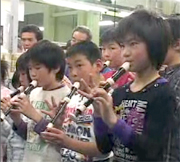The origins of the Recorder
History of the recorder - From its revival to present day
The man who revived the recorder for modern times
In the United Kingdom at the end of the 19th century, when there were signs of a revival in baroque music, a man named Arnold Dolmetsch, who was a violin teacher in London, was involved in research into historic musical instruments. Although the recorder had been left behind in the latter half of the 18th century, instruments, documentation, sheet music and other records still remained from a period that spanned the 15th to 18th centuries. Using instruments he had personally collected, Dolmetsch formed an ensemble with members of his family and played for fun in various locations.
It was during this time that a small but important incident occurred that marked a turning point in the history of the recorder. One day, Dolmetsch's son Carl, who was carrying one of the historic recorders that belonged to the family, left the instrument on the platform at a railway station when boarding a train. Although Arnold searched relentlessly for the instrument, it could not be found.
However, fortunately, he was able to create detailed schematics based on the documentation for the old recorder. Based on the schematic, Arnold began to produce recorders himself, which became key to the resurgence of these instruments in the 20th century.
The recorder's route to Japan's educational institutions
After that time, German national Peter Harlan made a recorder in a style intended to be easier to perform in C major, which has since come to be known as German-style fingering. Cheap and with easy-to-produce low tones, Harlan's German-style continued to be mass produced, and came to be used in formal education after the rise of the Nazi Party and their dominance of music and education.
In 1936 the Berlin Olympics were held, with recorder performances included in the celebrations, and at that time a Japanese national was in the audience. That was a man named Yoshitaka Sakamoto, who was studying abroad in Germany at the time. Seeing a performance by a large crowd of children playing recorders made a deep impression on him, and recognizing the educational value of the instrument he took soprano, alto and tenor models back to Japan with him when he returned. It was at that time that the recorder came to Japan. Sakamoto tried to produce these models of recorder in Japan, and petitioned Nihon Kangakki Kabushikigaisha (later Yamaha Corporation), where their manufacture began. What is understood to have been key to many schoolchildren in Japan today becoming familiar with the recorder is the story of Carl Dolmetsch's carelessness, but actually a number of different events were related to this development.
A wind instrument everyone has played once
Today, the recorder has become one of the most widely dispersed musical instruments. However, it has spread through use in a number of fields, in schools as an instrument for education being one, but also as a period instrument in revival performances of renaissance and baroque music, and in many soundtracks for television and film. Also, there are many contemporary works that have been written for the recorder, and while it continues to be used for teaching materials in schools, it is as illustrious as other members of the wind instrument family.

Historic shape preserved
The recorder is an instrument that was already fully formed in the first half of the 18th century. However, as it was completely forgotten by people for a period of time, its restoration from the 20th century onwards has preserved its historic shape. Perhaps for that reason, it is distinct from other instruments, having remained unchanged, and its historic form remaining intact.
Even now, a preference for its historic sound, as well as a desire to produce a historic musical instrument, are among the strongly charged sentiments that are inscribed by each maker for each variety into each model of the instrument that is produced.
It is precisely in that sense that they could be said to be among the musical instruments that should be described as "living fossils."
Yamaha manufactures recorders such as the re-released Denner* model wooden alto recorder, and the Rottenburg* style reproduction soprano recorder.
* Denner and Rottenburg are the inscription brand names of recorder manufacturers (makers)
